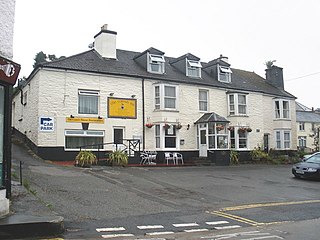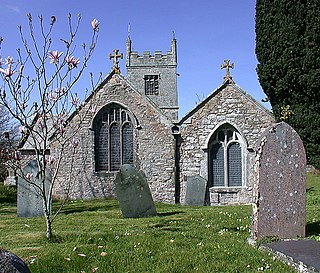
Calstock is a civil parish and a large village in south east Cornwall, England, United Kingdom, on the border with Devon. The village is situated on the River Tamar 6 miles (9.7 km) south west of Tavistock and 10 miles (16 km) north of Plymouth.

Pelynt is a civil parish and village in Cornwall, England, United Kingdom. It is 20 miles (32 km) west of Plymouth and four miles (6.5 km) west-northwest of Looe. Pelynt had a population of around 1,124 at the 2001 census which increased to 1,296 at the 2011 census. In addition, an electoral ward with the same name exists but extends towards Widegates avoiding Looe at all times. The population in 2011 for this ward was 4,453.

Gunnislake is a large village in east Cornwall, England, United Kingdom. It is situated in the Tamar Valley approximately ten miles (16 km) north of Plymouth The first woman cabinet minister in the British Empire, Mary Ellen Smith, was born here in 1863.

St Mary's Church is an Anglican parish church in the village of Newbold Astbury, Cheshire, England. It is recorded in the National Heritage List for England as a designated Grade I listed building, and its architecture has been praised by a number of writers.

The Church of St Morwenna and St John the Baptist is the parish church of Morwenstow, north Cornwall, England, United Kingdom, the most northerly parish in Cornwall. The church is dedicated to Morwenna, a local saint, and to John the Baptist, and is recorded in the National Heritage List for England as a designated Grade I listed building. It is an active Anglican parish church in the diocese of Truro, the archdeaconry of Bodmin, and the deanery of Stratton. Its benefice is combined with that of St James, Kilkhampton to form the United Benefice of Kilkhampton with Morwenstow.

St Maddern's Church is the parish church of Madron, near Penzance in Cornwall and was once the mother church of Morvah and Penzance. It is a Grade I listed building.

All Saints' Church is a 15th-century redundant church in the park of Harewood House, the seat of the Lascelles Earls of Harewood, near the village of Harewood, West Yorkshire, England.

The Church of Saint Laudus is an active parish church in Mabe, Cornwall, England, UK, originally built in the 15th century and dedicated to the sixth-century Saint Laudus of Coutances. It is part of the Church of England Diocese of Truro. Struck by lightning in the 19th century, much of it had to be rebuilt, though parts of the original church remain. It has been a Grade II* listed building since 10 July 1957.

St Michael and All Angels Church is a redundant Anglican church in the village of Edmondthorpe, Leicestershire, England. It is recorded in the National Heritage List for England as a designated Grade I listed building, and is under the care of the Churches Conservation Trust.

St Andrew's Church is a redundant Anglican church in the village of Redbourne, Lincolnshire, England. It is recorded in the National Heritage List for England as a designated Grade I listed building, and is under the care of the Churches Conservation Trust. The church stands in the centre of the village, which is to the east of the A15 road, and some 4 miles (6 km) south of Brigg.

St Mary's Church is in Church Avenue, Penwortham, Lancashire, England. It is an active Anglican parish church in the deanery of Leyland, the archdeaconry of Blackburn, and the diocese of Blackburn. The church is recorded in the National Heritage List for England as a designated Grade II* listed building.

St Andrew's Church is a Grade I listed church in Stratton, Bude, Cornwall. It is located along the main road in Stratton. The font is dated to the 12th century, the north aisle to the mid 14th. The tower, aisle and chancel date to the 15th century. The church was restored in 1888 by St Aubyn and Wadling. It became a Grade I listed building on 5 March 1952.

Colan Church also known as St Colan Church is a 13th-century church in Colan, mid-Cornwall, UK. Dedicated to St Colanus, it became a Grade I listed building in 1967. The vicars of St Columb Minor have served the church since the middle of the 20th century.

St Piran's Church is an active Anglican parish church in Perranarworthal, Cornwall, England. It is part of a united benefice consisting of eight churches, the Eight Saints Cluster, in the parishes of Stithians with Perran-Ar-Worthal and Gwennap. The benefice has four licensed clergy and four readers. The church, dedicated to Saint Piran, is in the Carnmarth, North deanery, the archdeaconry of Cornwall and the Diocese of Truro. The church was granted Grade II* listed status in May 1967. The churchyard contains several listed chest tombs and headstones.

The Church of St Peter is the 13th-century Anglican parish church for the village of Shirwell in North Devon. It is a Grade I listed building and comes under the Diocese of Exeter. The family church of the Chichester Family who lived locally, the aviator and sailor Sir Francis Chichester, who was born in Shirwell, is buried in the churchyard.

Harewood House was an ancient manor house, built originally by the Saxons, in Cornwall, England. Harewood Estate is surrounded by old mine workings, so the house faces towards Morwellham Quay.

St Martin and St Meriadoc's Church, Camborne is a Grade I listed parish church in the Church of England in Camborne, Cornwall.

St Julitta's Church, Lanteglos-by-Camelford is a Grade I listed parish church in the Church of England Diocese of Truro in Lanteglos-by-Camelford, Cornwall.

St Brevita's Church is a Grade I listed medieval parish church of the Church of England in Lanlivery, Cornwall. The church was built in the 14th and 15th centuries in the Perpendicular Gothic style, and is dedicated to Saint Bryvyth, or Brevita. Bryvyth's veneration is unique to Lanlivery and nothing is known about her. The churchyard contains multiple monuments, listed separately from the church itself.

St Mary's and St Julian's Church is a Church of England parish church in Maker, Cornwall, England, UK. The church dates to the 15th century and has been a Grade I listed building since 1968.























